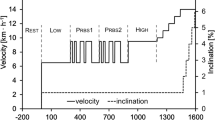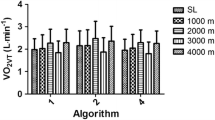Abstract
The aims of the present study were: (1) to assess aerobic metabolism in paraplegic (P) athletes (spinal lesion level, T4–L3) by means of peak oxygen uptake (V˙O2peak) and ventilatory threshold (VT), and (2) to determine the nature of exercise limitation in these athletes by means of cardioventilatory responses at peak exercise. Eight P athletes underwent conventional spirographic measurements and then performed an incremental wheelchair exercise on an adapted treadmill. Ventilatory data were collected every minute using an automated metabolic system: ventilation (l · min−1), oxygen uptake (V˙O2, l · min−1, ml · min−1 · kg−1), carbon dioxide production (V˙CO2, ml · min−1), respiratory exchange ratio, breathing frequency and tidal volume. Heart rate (HR, beats · min−1) was collected with the aid of a standard electrocardiogram. V˙O2peak was determined using conventional criteria. VT was determined by the breakpoint in the V˙CO2−V˙O2 relationship, and is expressed as the absolute VT (V˙O2, ml · min−1 · kg−1) and relative VT (percentage of V˙O2peak). Spirometric values and cardioventilatory responses at rest and at peak exercise allowed the measurement of ventilatory reserve (VR), heart rate reserve (HRr), heart rate response (HRR), and O2 pulse (O2 P). Results showed a V˙O2peak value of 40.6 (2.5) ml · min−1 · kg−1, an absolute VT detected at 23.1 (1.5) ml · min−1 · kg−1 V˙O2 and a relative VT at 56.4 (2.2)% V˙O2peak. HRr [15.8 (3.2) beats · min−1], HRR [48.6 (4.3) beat · l−1], and O2 P [0.23 (0.02) ml · kg−1 · beat−1] were normal, whereas VR at peak exercise [42.7 (2.4)%] was increased. As wheelchair exercise excluded the use of an able-bodied (AB) control group, we compared our V˙O2peak and VT results with those for other P subjects and AB controls reported in the literature, and we compared our cardioventilatory responses with those for respiratory and cardiac patients. The low V˙O2peak values obtained compared with subject values obtained during an arm-crank exercise may be due to a reduced active muscle mass. Absolute VT was somewhat comparable to that of AB subjects, mainly due to the similar muscle mass involved in wheelchair and arm-crank exercise by P and AB subjects, respectively. The increased VR, as reported in patients with chronic heart failure, suggested that P athletes exhibited cardiac limitation at peak exercise, and this contributed to the lower V˙O2peak measured in these subjects.
Similar content being viewed by others
Author information
Authors and Affiliations
Additional information
Accepted: 22 April 1997
Rights and permissions
About this article
Cite this article
Vinet, A., Le Gallais, D., Bernard, P. et al. Aerobic metabolism and cardioventilatory responses in paraplegic athletes during an incremental wheelchair exercise. Eur J Appl Physiol 76, 455–461 (1997). https://doi.org/10.1007/s004210050275
Issue Date:
DOI: https://doi.org/10.1007/s004210050275




